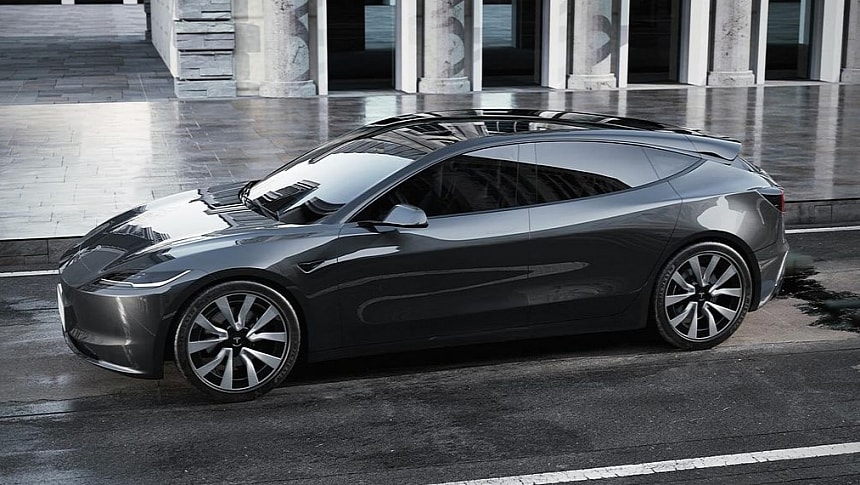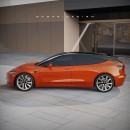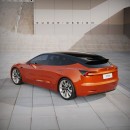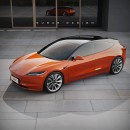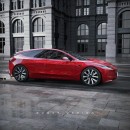During the first quarter earnings call, Musk dodged questions about Tesla's affordable EV model and the upcoming robotaxi, which will be unveiled on August 8. However, the shareholder deck hinted at launching an affordable EV model using the existing architecture and production lines. Later, rumors indicated that Tesla might launch a low-cost variant of the Model 3, possibly as a hatchback.
Based on last year's Investor Day information, Tesla was expected to launch an affordable EV model from its most advanced manufacturing facility in Mexico. The announcement thrilled Tesla fans and investors alike, as this was Tesla's ticket to achieving 20 million EV yearly sales by 2030. The affordable EV would use a revolutionary manufacturing process called "unboxed vehicle," allowing it to cut costs in half compared to Model 3/Model Y.
The compact EV model was supposed to share Tesla's Gen-3 vehicle architecture with a robotaxi, which was Elon Musk's dream since the Master Plan Part Deux times. However, Musk had second thoughts about these plans, like he had several times before. Last year, we found out that Tesla would not start affordable EV production in Mexico but at Giga Texas. The unboxed-vehicle process will also be implemented there first. Tesla fans were still cheering, thinking this would bring the $25,000 model faster to the market.
However, their hopes were crushed when Reuters reported that Musk canceled the affordable EV project. Musk called Reuters reporters liars but did nothing to clarify what was happening. To add to the confusion, Musk announced that Tesla would unveil a robotaxi on August 8 (8/8), a combination considered lucky in Chinese culture. This hints that the unveiling might occur in China and not in Austin, as most people thought.
The affordable EV project's fate remained uncertain, with some believing that it was canceled, while others were more optimistic. People thought Musk would offer some clarity during the Q&A session at the first quarter earnings call. However, Musk and other Tesla executives dodged the questions, telling everyone to wait for the official event on August 8. However, the Q1 2024 shareholder deck briefly touched on Tesla's plans, adding more to the confusion instead of clarifying anything.
The shareholder deck left out the project cancelation. Instead, it claimed that Tesla would accelerate the launch of new models "ahead of our previously communicated start of production in the second half of 2025." However, the new vehicles, "including more affordable models," will not use the unboxed vehicle manufacturing process.
Instead, they will mix aspects of the next-generation platform with elements of the current vehicle architecture. This approach will allow Tesla to produce them using the same production lines as current models. The reason for this is pretty transparent: cutting development costs, even though this provides fewer cost benefits in the long run. In other words, Tesla will produce cost-optimized variants of the current models even though this will result in more expensive products than the previous Gen-3 vehicles.
That's the part confirming that a $25,000 EV model is no longer on Teska's roadmap, although Tesla fans now claim it never was. Tesla is probably wise to try to exhaust its current production capacity before expanding it with new factories. However, shelving the affordable EV project means abandoning this market segment to Chinese companies and jeopardizing future growth plans.
The upcoming robotaxi will be the only model "pursuing" the revolutionary unboxed manufacturing strategy. This doesn't sound too confident and offers no guarantee that Tesla will make at least the robotaxi using the cost-efficient process. It also confirms that Giga Mexico is essentially dead in the water unless the robotaxi starts volume production and needs additional capacity.
The most interesting information from the shareholders' deck is that Tesla will produce new models mainly using the current platforms. Since the plan is to make several models, I think the refreshed Model Y might be the first to introduce elements from the next-gen architecture. However, the Model 3 has the most to gain from the switch, considering it hasn't yet adopted the manufacturing advancements introduced with the Model Y.
The Model 3 doesn't yet use megacastings and relies on the classic body stamping and welding process. That's one of the biggest cost-efficiency measures that Tesla will adopt in transitioning the Model 3 to a "Gen-2.5" architecture. Rumors from China also indicate that Tesla might bring a new body style, sort of like a Model 3 hatchback, specifically for the European and Chinese markets.
The Model 3 hatchback will use a smaller battery pack (around 50 kWh) to cut costs. However, it will be lighter and more efficient due to using megacastings and more advanced drive units. The battery pack will undoubtedly use LFP cells, although the latest advancements will make them close to current ternary cells in terms of charging performance and energy density. Chinese companies like CATL and BYD are the likely suppliers for the cells, meaning the 4680 cell project might be axed in another cost-cutting move.
As for the elements of the next-generation architecture, Tesla is most probably referring to the 48-volt electrical system and steer-by-wire system, which have already been tested with the Cybertruck. Wiring simplification will save some weight and costs for the next EV, which could start production next year. Regarding price, it's obvious that Tesla is targeting the $30-32,000 bracket, which sits in the middle between the $25,000 next-gen EV and the $39,000 of the current Model 3.
The compact EV model was supposed to share Tesla's Gen-3 vehicle architecture with a robotaxi, which was Elon Musk's dream since the Master Plan Part Deux times. However, Musk had second thoughts about these plans, like he had several times before. Last year, we found out that Tesla would not start affordable EV production in Mexico but at Giga Texas. The unboxed-vehicle process will also be implemented there first. Tesla fans were still cheering, thinking this would bring the $25,000 model faster to the market.
However, their hopes were crushed when Reuters reported that Musk canceled the affordable EV project. Musk called Reuters reporters liars but did nothing to clarify what was happening. To add to the confusion, Musk announced that Tesla would unveil a robotaxi on August 8 (8/8), a combination considered lucky in Chinese culture. This hints that the unveiling might occur in China and not in Austin, as most people thought.
The shareholder deck left out the project cancelation. Instead, it claimed that Tesla would accelerate the launch of new models "ahead of our previously communicated start of production in the second half of 2025." However, the new vehicles, "including more affordable models," will not use the unboxed vehicle manufacturing process.
Instead, they will mix aspects of the next-generation platform with elements of the current vehicle architecture. This approach will allow Tesla to produce them using the same production lines as current models. The reason for this is pretty transparent: cutting development costs, even though this provides fewer cost benefits in the long run. In other words, Tesla will produce cost-optimized variants of the current models even though this will result in more expensive products than the previous Gen-3 vehicles.
That's the part confirming that a $25,000 EV model is no longer on Teska's roadmap, although Tesla fans now claim it never was. Tesla is probably wise to try to exhaust its current production capacity before expanding it with new factories. However, shelving the affordable EV project means abandoning this market segment to Chinese companies and jeopardizing future growth plans.
The upcoming robotaxi will be the only model "pursuing" the revolutionary unboxed manufacturing strategy. This doesn't sound too confident and offers no guarantee that Tesla will make at least the robotaxi using the cost-efficient process. It also confirms that Giga Mexico is essentially dead in the water unless the robotaxi starts volume production and needs additional capacity.
The Model 3 doesn't yet use megacastings and relies on the classic body stamping and welding process. That's one of the biggest cost-efficiency measures that Tesla will adopt in transitioning the Model 3 to a "Gen-2.5" architecture. Rumors from China also indicate that Tesla might bring a new body style, sort of like a Model 3 hatchback, specifically for the European and Chinese markets.
The Model 3 hatchback will use a smaller battery pack (around 50 kWh) to cut costs. However, it will be lighter and more efficient due to using megacastings and more advanced drive units. The battery pack will undoubtedly use LFP cells, although the latest advancements will make them close to current ternary cells in terms of charging performance and energy density. Chinese companies like CATL and BYD are the likely suppliers for the cells, meaning the 4680 cell project might be axed in another cost-cutting move.
As for the elements of the next-generation architecture, Tesla is most probably referring to the 48-volt electrical system and steer-by-wire system, which have already been tested with the Cybertruck. Wiring simplification will save some weight and costs for the next EV, which could start production next year. Regarding price, it's obvious that Tesla is targeting the $30-32,000 bracket, which sits in the middle between the $25,000 next-gen EV and the $39,000 of the current Model 3.
